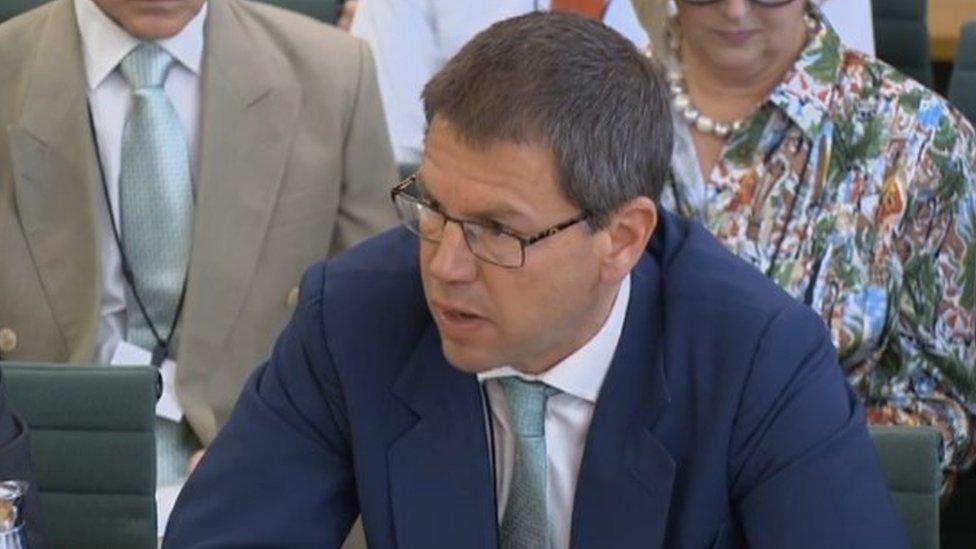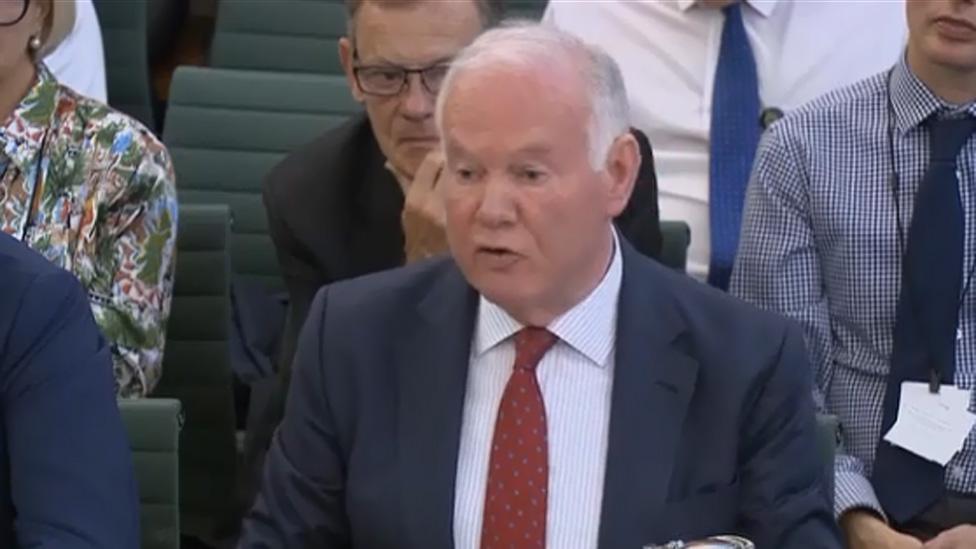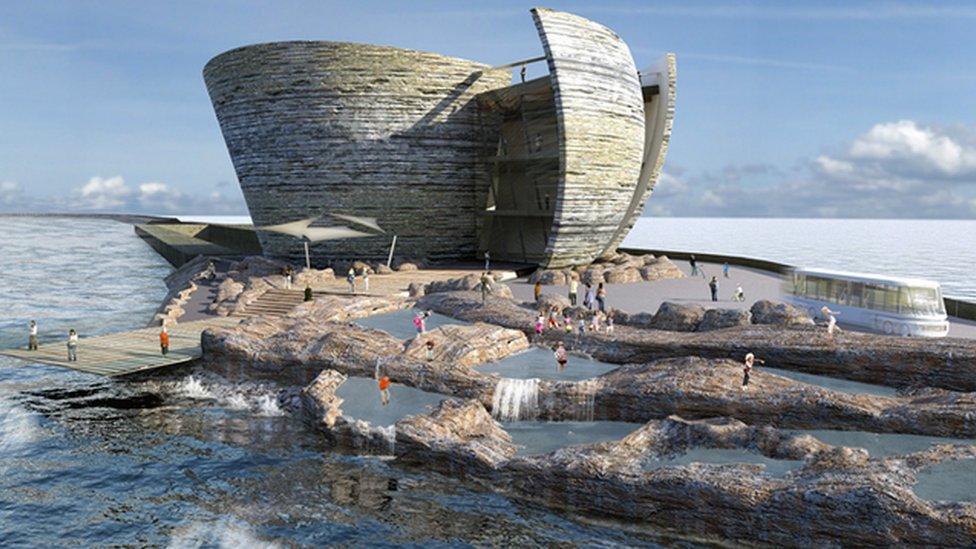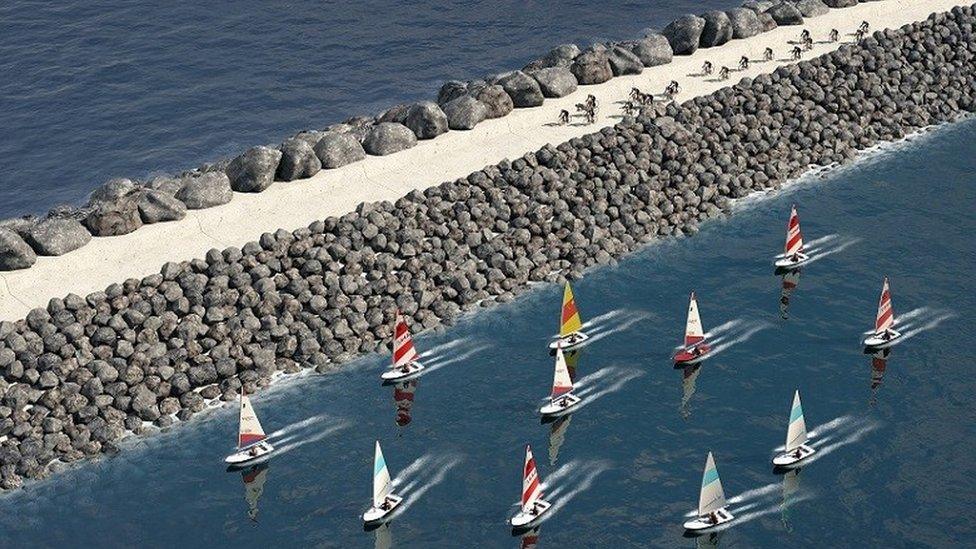Swansea tidal lagoon boss 'not met minister for 16 months'
- Published

An artist's impression of the proposed lagoon across Swansea Bay
The head of a firm hoping to build the Swansea Bay tidal lagoon has not met a UK government minister for 16 months.
Mark Shorrock of Tidal Lagoon Power (TLP) said he would "love to know what's going" on as ministers decide whether to approve the £1.3bn project.
He also told MPs three firms in TLP's supply chain had gone into administration and his own company had let some people go.
An independent review backed the renewable energy project in 2017.
Mr Shorrock, giving evidence to a joint Business, Energy and Industrial Strategy and Welsh Affairs committee inquiry in London, said he had not had a face-to-face meeting with a minister since then and had only communicated with cabinet minister Greg Clark by letter.
Agreement is needed about the price to be paid for electricity from the scheme before it can go ahead.
The chief executive of Tidal Lagoon Power (TLP) also faced scrutiny over the scheme's cost and environmental impact.
UK and Welsh government ministers are set to appear before MPs at a later date, as the committees continue their investigation into the delays the project has faced.

There's more on this story:


Mark Shorrock was challenged over the subsidy needed to make the project viable
A summary of what did we learnt today
Q: What is happening with the negotiations between the UK government and the developers?
"I don't know," Mr Shorrock told MPs.
He said the last meeting TLP had with the department for Business, Energy and Industrial Strategy (BEIS) was in January 2017.
They met then-Business Minister Jesse Norman, a week after an independent review commissioned by the UK government into the viability of the tidal lagoon scheme called for it to go ahead.
So far there has been no official response to the review's findings.
Mr Shorrock claimed the only contact with Business Secretary Greg Clark was a letter in February 2018 acknowledging an offer of investment made by the Welsh Government to try to get the project over the line.
There had been no formal meeting with Welsh Secretary Alun Cairns either since late 2016, though Wales Office officials had told the developers they were "encouraging a decision" and were "very positive".
Q: What impact is the wait for news having?
Mr Shorrock claimed three companies that would have been part of the lagoon's supply chain had gone into administration.
"We could have been a lifeline for them," he said.
Internally, several staff have been let go but the developer had held on to "all our core delivery capability" as they wait for a decision.
"It's very costly - a burn-rate of some several hundred thousand pounds a month to maintain."
Q: What are the developers asking for from the UK government?
Mr Shorrock came under pressure to spell out the terms of the deal his company had offered the UK government.
He claimed the recent announcement that the Welsh Government would make a "substantial investment" in the scheme means they could work with a strike price that averages out at about £92.50 per megawatt hour - and was agreed for Hinkley Point C nuclear plant.
But they want to structure the support so it is spread out over 60 years rather than 35, descending over time.
Rachel Reeves MP questioned whether that was using an "additional subsidy" from the Welsh Government on top of the subsidy the developers were already seeking from the UK government.
Mr Shorrock said Welsh ministers recognised an "enormous opportunity for Wales to have a global sector" and that their "commercial equity investment would be fully repayed".
But without the Welsh Government's involvement, Mr Shorrock admitted the company would need a strike price of £150 per megawatt hour over 35 years.
Richard Howard, head of research at Aurora Energy Research Ltd, said he was not convinced the government would agree to another Hinkley-style deal given that other more-established renewable energy schemes, such as offshore wind farms, were much cheaper.
He criticised a lack of transparency about the company's offer on price, claiming there had been "no details in the public domain".
Q: What does the author of the tidal lagoon review think?
Charles Hendry, a former Conservative energy minister, said he stood by his report which hailed the tidal lagoon as a "no-regrets option".
If anything, he said he believed it more so now than he did when the review was published.

Charles Hendry took eight months to examine the project's viability
He claimed the scheme fitted in very well with the government's recently-launched industrial strategy and offered an "Olympic Games" of opportunity for south Wales.
He said the argument there were cheaper alternatives available in wind and solar developments "fights against innovation", claiming offshore wind had been offered a very high strike price initially to help the sector get off the ground.
Mr Hendry was upbeat about the project's prospects despite the delay.
"Disappointment for me would be if the government had said no. They haven't done so - this is still in play and I think that's a good indicator".

Watch Tidal Lagoon Power's video of how the turbines would work
Tidal lagoon: The timeline
2003: Plans first emerge for a £30m tidal power project in Swansea Bay from a green energy charity
2006: Tidal Electric Ltd prepares a scoping report for a lagoon to take the project on but it is put on hold
2012: Tidal Lagoon Power (TLP) unveils its ambition to develop a breakwater and power generation
2013: TLP starts developing its plans
2014: Plans submitted to the Planning Inspectorate at a cost of £850m
2015: Proposals get backing of the UK government, subject to subsidy agreement - with the hope it could be operational by 2018
2016: Report warns of impact on fish. Charles Hendry appointed to lead an independent review into £1.3bn lagoon's viability
2017: Hendry review backs the lagoon as a "no regrets" option but UK government is still to decide
2018: Delays, mostly believed to be over arguments over value for money. Welsh Government also offers substantial investment


A decision on the Swansea tidal lagoon is still awaited, 16 months after an independent review reported back
Q: What about the environmental concerns?
The RSPB told MPs it had been supportive of the Swansea Bay lagoon as a test of the technology but had become "more reluctant" due to how long it was taking for the project to be granted a marine licence.
The developers have been in discussion with Wales' environment body Natural Resources Wales (NRW) for four years, with the impact the lagoon's 16 large turbines could have on fish being the main sticking point.
Mark Shorrock said TLP had been working with the UK government's environment advisers CEFAS on new modelling which suggested the impact was "negligible".
NRW said it was expecting more information from the developers later this month, but would not be drawn on when it expected to come to a final decision.
"It's important to put into context that this is a novel development," said John Wheadon, NRW's permitting service manager.
The committee asked NRW to provide details about how much money it had spent so far on the marine licensing process.
"We find it surprising about the time (it's taken) and lack of clarity," said Rachel Reeves MP, "greater transparency about your decision making process would be welcome - please come back to us about that."
MPs also raised concerns about TLP's plans to reopen a disused quarry which would impact on a Marine Conservation Zone off the Cornish coast in order to provide rocks for the lagoon.
- Published3 May 2018

- Published1 May 2018

- Published10 January 2018
